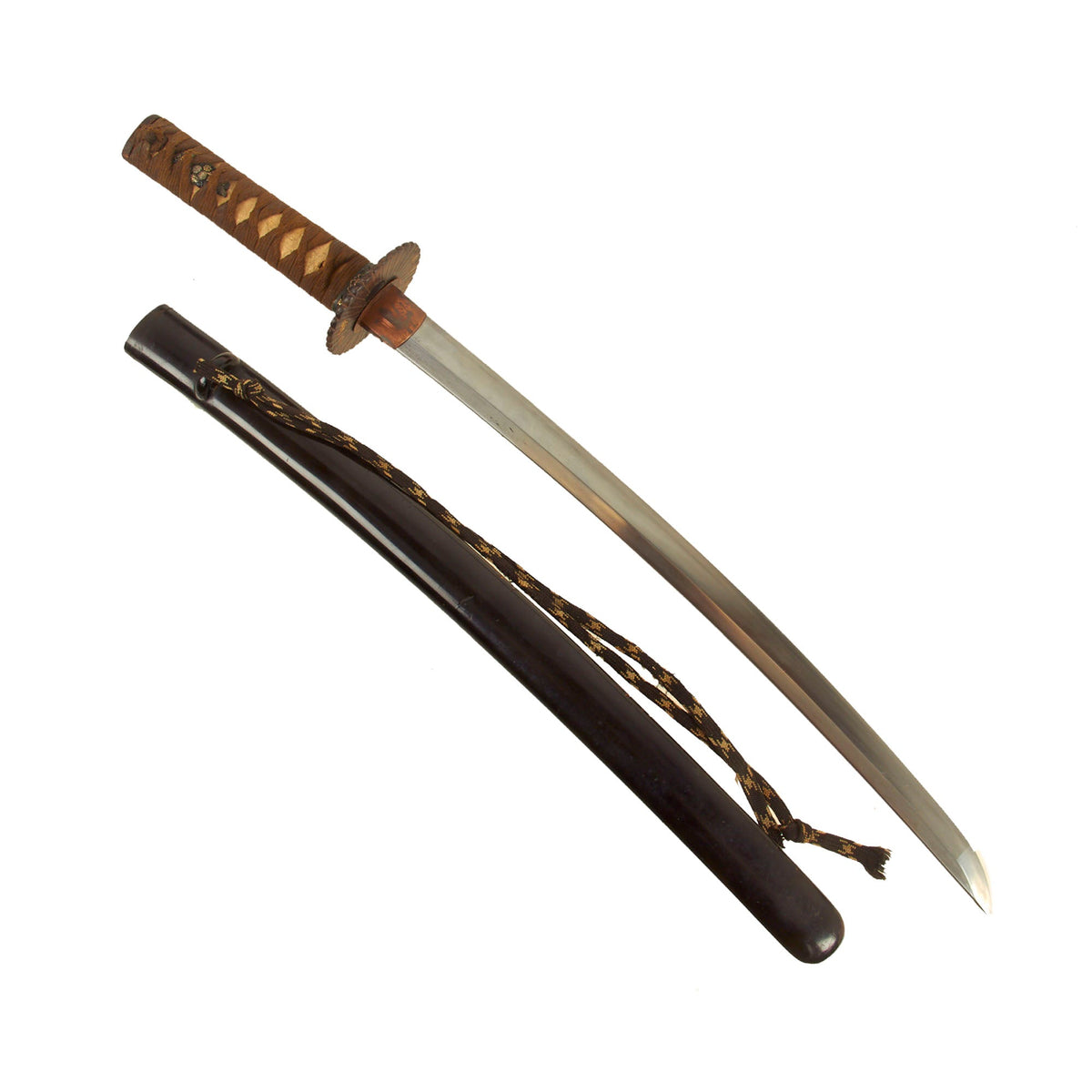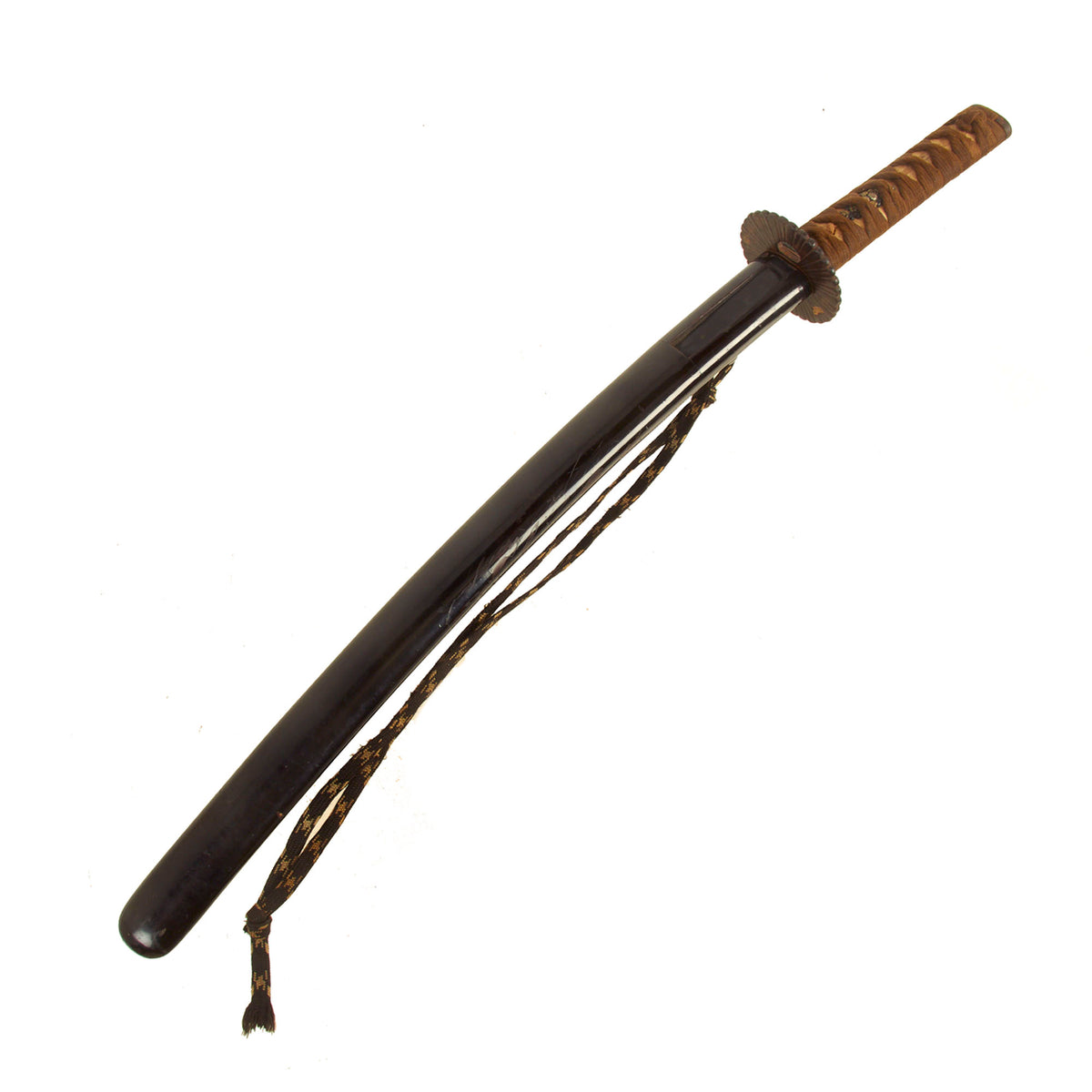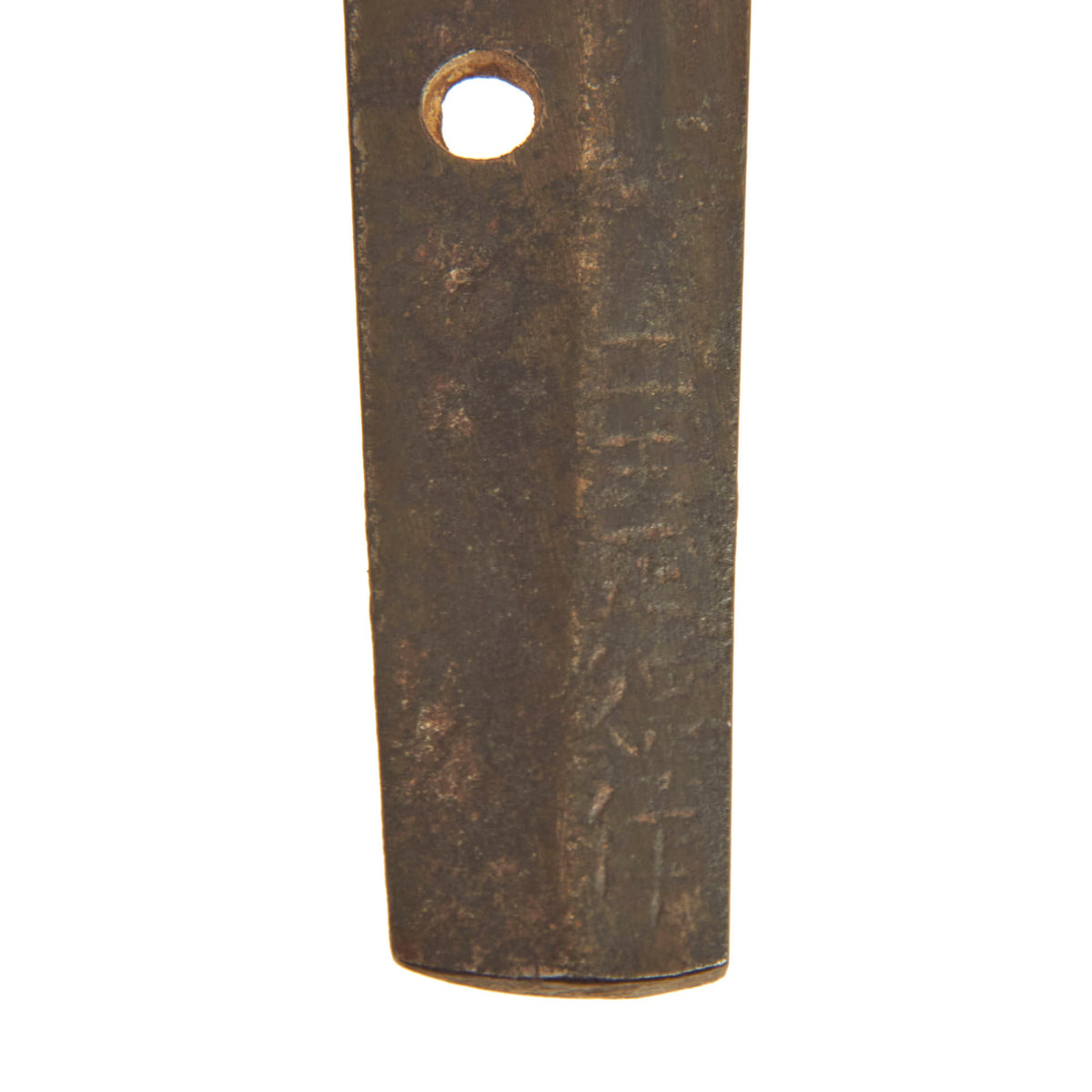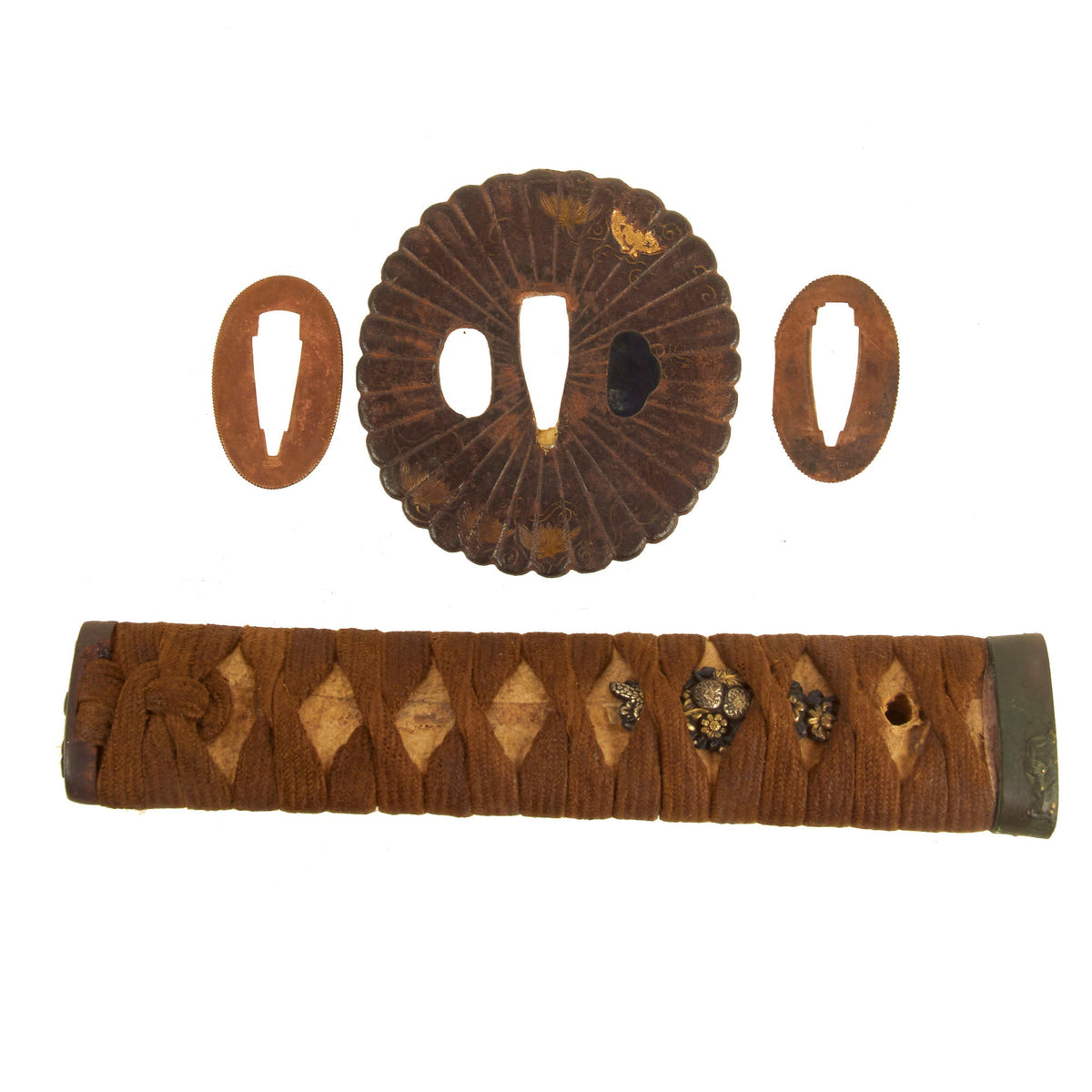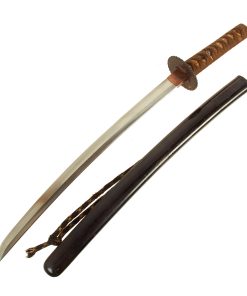Original 15th Century Japanese Handmade Wakizashi Short Sword by NIOH MASATSUNA with Scabbard & Sageo Original Items
$ 2.495,00 $ 623,75
Original Item: Only One Available. Wakizashi (脇差 “side inserted / companion sword”) is a general term for a sword with an edge between one and two shaku long (30 cm and 60 cm), predominantly made after 1600. Generally it is the short blade that accompanies a katana in the traditional samurai daisho pairing of swords, but may be worn by classes other than the samurai as a single blade, also worn edge up as the katana. Here we have a wonderful example in good polish, with a very nice lacquered scabbard and some great fittings.
We had this sword examined, and we believe this example dates from the Muromachi period (室町時代 Muromachi jidai) of 1336 to 1573, during the later circa 1500. This is part of the period of Japanese swordmaking known as Kotō (古刀”old swords”), the the type of swords that later smiths treated as the goal they needed to achieve. The fittings may be of later manufacture, but are still centuries old. Most likely this sword was brought back just after WWII, as many swords were turned in as required by the Allied forces.
This example has definitely been remounted several times, as was common for Japanese blades that are several hundred years old. It has three mounting holes, and we can definitely tell that the blade was once longer, cut down through the process of SURIAGE. If a blade is shortened, it can only be done from the tang end, to preserve the tip of the blade (kissaki) and tip temper line (boshi). The tang on such a blade is cut straight across at the bottom (kiri). Age and wear have made the file marks (yasurimi) on the tang faint, and given it a lovely patina. This has however also made the mei, or signature on the blade harder to read, and removed the tagane (chisel marks) and tagane-makura (raised area around the mei).
As best we can tell, the blade is signed 二 王 正 綱 作 – NIOH MASATSUNA SAKU, which basically translates to “Masatsuna Nioh Made This”. There is not much information available on this smith, however they were known to have worked in the 15th century. There is an example signed by this same smith in the Metropolitan Museum of Art Collection: Blade and Mounting for a Sword (Katana). Definitely a good opportunity for further research!
The blade has the following period correct features:
– Blade is signed on the tang by the maker (mei).
– Folded steel blade (fold lines are evident on the spine and body of the blade)
– Multiple Holes (mekugi-ana) in the tang are punched and not drilled
– Visible temper line (“hamon”) running full length of blade cutting edge.
– Hada or Grain is visible throughout the blade surface.
– Blade wounds (kizu) or lamination artifacts are present on the blade. Both ware (lamination lines) and fukure (carbon pits) are visible.
Offered in very nice condition, the polish on the blade of this example is in very good condition, though it does look to have been cleaned with uchiko powder since the last traditional polish. There is no oxidation we can see, though there is some light scuffing, and the geometry of the shinogi (blade ridge) is a bit softened. The blade length is approximately 17 11/16″ and overall length 25 1/2″. It has a futsu 普通 (regular) Nakago with a KIRI (cut) nakago-jiri (tang tip). The blade shape is a SHINOGI-ZUKURI (鎬造), which means that it has a SHINOGI (鎬 – Blade ridge). This is the standard shape for almost all Japanese blades, and the standard for Katanas, as well as many Wakizashi. As this is a longer Wakizashi, some would term this an O-Wakisashi, resembling a short katana.
The hamon (刃文 – temper line) is still easily visible, and is of the SUGUHA (直刃 or straight) type, with just a bit of irregularity in areas. We can still easily see NIE crystallization, with the NIOI cloudiness in the hamon. There is definitely lots of activity along the transition to the hamon. The YOKOTE (横手) is still faintly visible, and the BOSHI (帽子 – tip temper line) is of the KOMARU (small turnback) type. There are blade wounds including ware (lamination splits) and fukure (Carbon pits). The sword has a copper Habaki (blade collar), which is typical of the Edo period, probably from the last time it was refit.
The tsuba (cross guard) is made of iron and is of the Kiku Gata (Chrysanthemum) shape, with lots of brass inlay work on both sides, as well as some gilding. It originally had Hitsu-ana (accessory holes) for both the Kozuka (kogatana handle) and kogai (hair ornament), however the kogai side was plugged up because there is not one with this set of fittings. There are two seppa around the tsuba, with one cutout slightly matching the hitsu-ana on the tsuba.
The fuchi (collar) for the tsuka (handle) is made from blacked brass, and has some designs on it, while the Kashira (End Cap) is made of iron, with a floral brass inlays. There are two matching brass menuki grip ornaments present, which are floral arrangements. The soft leather grip is in good condition, and the golden brown grip wrapping (Ito) is in very good condition, possibly having been redone in the early 20th century. There is a single wooden securing peg (mekugi) still present, which looks to be original.
The sword comes in a black enamel lacquer wooden scabbard (saya), which is probably edo period, and is in very good condition. There is denting and chipping of the enamel, but no splitting along the seam, and it has a kurikata (knob) one one side with an attached sageo (sword cord). There is also a slot on the other side for storage of a kogatana knife, however there is not one included in this offering.
A very nice Muromachi Period wakizashi by a known smith with some very interesting fittings (koshirae). Ready to research and display!
Specifications (Wakizashi):
Blade Length: 17 11/16″
Blade Shape: Hira-Zukuri
Overall length: 25 1/2“
Scabbard Length: 20″
It has been over one thousand years ago that the art of making swords appeared in Japan. The swordsmiths of the time may not have known it but they were creating a legendary sword. The Samurai sword has seen combat in many battlefields. From the early days of the Samurai warrior to the fierce battles in the South Pacific during WWII.
Each hand-made Japanese blade (日本刀 – Nihonto) is unique because it is forged from multiple pieces of folded steel stock. A tremendous amount of work is dedicated to creating these pieces. They were an instrument of war as much as a beautiful artifact to adorn a room.
The traditional Japanese blade and mountings have grown to be one of the most highly desired military antiques.
Fast Shipping with Professional Packaging
Thanks to our longstanding association with UPS FedEx DHL, and other major international carriers, we are able to provide a range of shipping options. Our warehouse staff is expertly trained and will wrap your products according to our exact and precise specifications. Prior to shipping, your goods will be thoroughly examined and securely secured. We ship to thousands clients each day across multiple countries. This shows how we're dedicated to be the largest retailer on the internet. Warehouses and distribution centres can be located throughout Europe as well as the USA.
Note: Orders with more than one item will be assigned a processing date depending on the item.
Before shipping before shipping, we'll conduct a thorough inspection of the items you have ordered. Today, the majority of orders will be delivered within 48 hours. The delivery time will be between 3-7 days.
Returns
The stock is dynamic and we cannot completely manage it because multiple stakeholders are involved, including our factory and warehouse. So the actual stock may alter at any time. It's possible that you may not receive your order once the order has been made.
Our policy is valid for a period of 30 days. If you don't receive the product within 30 days, we are not able to issue a refund or an exchange.
You can only return an item if it is unused and in the same state as the day you received it. You must have the item in its original packaging.
Related products
Uncategorized
Uncategorized
Band of Brothers ORIGINAL GERMAN WWII Le. F.H. 18 10.5cm ARTILLERY PIECE Original Items
Uncategorized
Uncategorized
Uncategorized
Uncategorized
Uncategorized
Uncategorized
Uncategorized
Uncategorized
Armored Burgonet Helmet & Polearm from Scottish Castle Leith Hall Circa 1700 Original Items
Uncategorized
Uncategorized
Uncategorized
Uncategorized
Uncategorized
Uncategorized
Uncategorized
Uncategorized

